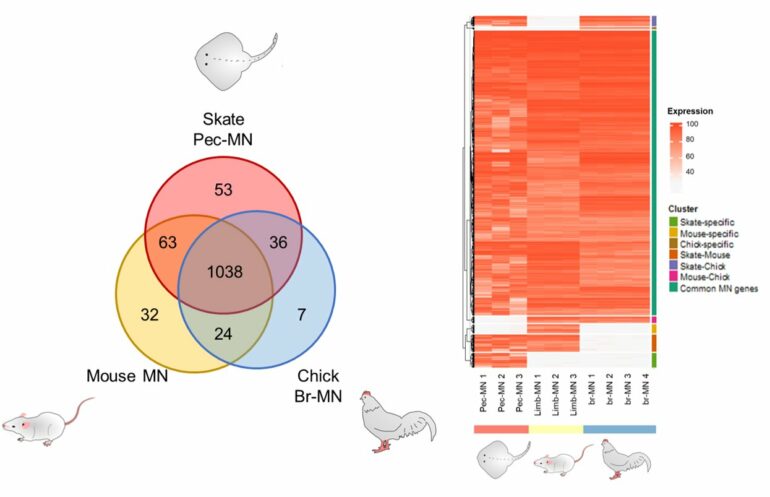Although the little skate is a fish, it is known for using its fins like legs to walk, similar to terrestrial vertebrates. The little skate is thought to have diverged from a common ancestor with terrestrial tetrapods about 470 million years ago. It was reported in previous studies that the motor nerve network involved in the walking of little skates and tetrapods are similar, but it was difficult to study the molecular mechanism of how these motor nerve network evolved because there was no high-quality whole-genome of the little skates.
In a study now published in eLife, a research team constructed a high-quality whole-genome of the little skate using the latest genome analysis technology. The size of the newly constructed whole-genome of the little skate is 2.13 gigabytes, which is 93% of the predicted genome size, and is a high-quality whole-genome containing 17,230 genes encoding proteins.
Furthermore, the research team performed a comparative analysis with terrestrial animals. A comparative analysis of the transcriptomes of the little skate and tetrapod motor neurons was performed using the high-quality whole-genome of the little skate. Based on these results, genes expressed in common and genes expressed differentially were discovered in the motor neurons.
In the little skate, 10 muscles are involved in walking with fins, whereas in tetrapods, 50 muscles are involved in moving the limbs. By comparing the two species, the research team suggested a molecular mechanism for how the simple walking pattern and the sophisticated movements seen in terrestrial tetrapods emerged during evolution.
This research was led by Professor Baek Myung-In of the Department of Brain Sciences, DGIST and was conducted together with research teams from Seoul National University and New York University Medical School. Its significance is that it presented the molecular mechanism of evolution of walk-related motor nerve networks by putting together specialized research capabilities in the fields of comparative biology, genomics, and neurobiology.
Professor Baek Myung-in of the Department of Brain Sciences said, “There are both simple and sophisticated forms of walking, and this is a groundbreaking discovery that suggests the molecular mechanism of how these forms arose in the long evolutionary process.”
More information:
DongAhn Yoo et al, Little skate genome provides insights into genetic programs essential for limb-based locomotion, eLife (2022). DOI: 10.7554/eLife.78345
Provided by
DGIST (Daegu Gyeongbuk Institute of Science and Technology)
Citation:
Solving the mystery of the ‘little skate,’ a fish that walks on two legs (2022, December 14)



